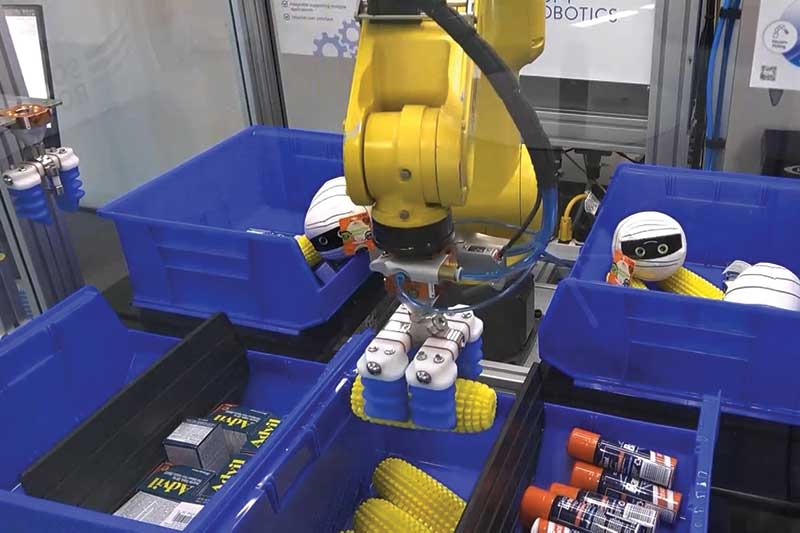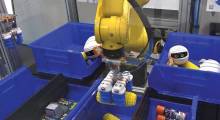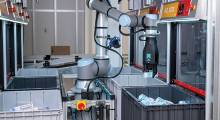Unfortunately, we only have 3,600 seconds in an hour.
Otherwise, who knows what picking technologies could do with some extra time.
But since more seconds is not an option, we need to find other ways to get more done every hour. So, we do.
Luther Webb, Trew’s vice president of data science, has a graph in mind. His title should have been a tip off he’d go down this path.
Webb immediately goes into an X-Y axis discussion with order velocity on the former and SKU population on the latter. Imagine a graph where in the middle is a line that starts with manual picking technologies, goes to mechanized ones and finishes at the top end with automation.
It seems Webb is telling us that no one really needs more than 3,600 seconds in an hour. Instead, all that’s needed is a range of picking technologies that accommodate specific conditions. Piece of cake.
In fact, developments in picking technologies are quite active these days. And those developments run up Webb’s graph from the more manual pick-to-light technology all the way up to the most autonomous mobile robots (AMRs). If you haven’t been tracking things lately, you’re likely to be surprised at the latest options.
The baseline
“It’s all pretty exciting,” says Tony Del Cid, director of applications engineering at Tompkins Solutions. “No one solution fits all. But the right solutions are always nimble and able to adjust to changes in SKUs, order profiles, customers and operations,” says Del Cid.
The four key words here whether you’re talking goods-to-person and/or person-to-goods picking technologies are:
- variability
- flexibility
- scalability, and
- integration.
Probably the scariest word is the first. Variability first surrounds and then sometimes suffocates picking operations. Worse yet, no picking technology has control over what’s coming at it.

But there shouldn’t be a sense of hopelessness here, says Anthony Romeo, product marketing manager at Soft Robotics. “Companies are investing in technology to overcome variability and outside obstacles where they can,” he adds.
Options here definitely tend to be most available at the high end of the graph, especially with robotic systems. Tools such as vision and artificial intelligence (AI) are essential to managing variability, says Romeo. Those tools also make the automated picking system that much more valuable in the picking process, he adds.
Then there’s the matter of flexibility. With a more manual system such as pick-to-light and its reliance on people, flexibility can be maximized, says Bernie McCabe, sales manager at Lightning Pick from Matthews. McCabe is quick to say “too much automation can lack the flexibility that more manual systems enjoy.” And he’s right, however…
That does not mean automated picking technologies are not flexible. Anything but.
Automation is, instead, most effective working within the envelope developed for it to be most efficient without human intervention. Just as important, those envelopes are expanding, says Romeo.
“People want more applications for robots and other types of automation that are increasingly complicated. And suppliers are on a path to delivering just that. Automated picking solutions are set to only grow,” adds Romeo.
Staying with the flexibility theme, it’s also worth noting that human involvement in robotic systems is neither out of the norm nor a sign of failure.
Kevin Heath, director of robotics and AMR at Dematic, says that, in general, 65% to 80% of parts are robot pickable today. And while that number may get closer to 100%, it will never be entirely achievable. “Robotic piece picking will always require some human intervention.”
Heath is much more focused on what he calls operational optimization. It’s a matter of removing people from the mix as much as possible.
That’s also much the view from Jan Zizka, CEO of Brightpick.
“It’s inevitable that a robotic arm will sometimes be unable to pick an item it is supposed to pick, especially if that item is damaged in some way,” says Zizka. That’s why it’s important for any robotic picking solution to have a fallback human-based option.
Which brings us to scalability.
“This is the story about a technology’s ability to expand speed and throughput to keep pace with an expanding business,” says John Sauer, senior director of global business development at Opex. Scalability, he notes, is also an extension of flexibility relating to changes over time in the items picked.
Still another aspect of scalability, says Sauer, is system expansion over time. “Systems need to be built with room to scale, to expand, with the business over time. But that time frame is best kept to three years or fewer. We are not talking 10 years out,” Sauer says.
He adds one final thought here. “We’re not focused in scaling systems to peaks. The best approach is not to build the church to accommodate Easter every day of the year,” Sauer adds.
Brendon Bielat, vice president of product and marketing at RightHand Robotics, adds some other factors to scalability.
Four to be precise.
Scalability to Bielat includes; increased range of the technology; improved reliability, greater autonomy; and an enhanced ease of integration.
In other words, scalability may sound simple, but it’s not a given. And what’s mentioned here only scratches the surface, for sure.
The final word in the list is integration. This can be a tough one. Picking is one of many activities in a facility. Picking technologies are just part of an overall mix of equipment. All picking technologies are optimized to pick items and move them to their next destination.
Sometimes, it’s too easy to allow the specialized activity of picking technologies to isolate them from other warehouse operations. That’s where integration enters. Picking technologies have to be integral to the flow not isolated from the flow of items. That’s the big picture of integration.
Strong, silent data
How do you get all this accommodated?
“Data is key to finding the right picking technology for your operation,” Webb says. “You need to capture data about everything from your SKUs and their profile to the inbound history of receipts to order history, shipment history and overall inventory history,” he adds.
With all that data mined, Webb moves on to analyzing it to determine the time to value for each picking technology under consideration.

“You need to decide what’s best for your operation. What results can be achieved. How long it will take to achieve. And, ultimately what is the ROI. Taken as a whole, that’s time to value, and it is the central tenet of picking technologies today,” says Webb.
What’s new in picking
We’re going to start here with pick-to-light. Traditionally known as a point solution, pick-to-light is now a solution-based platform, says McCabe. Yes, times and warehouse demands have changed.
The pick-to-light lineup now includes light-directed picking and order replenishment as well as put-to-light and mobile carts. Low-volume RF picking is now in place along with build-to-light for manufacturing. Some systems don’t even have lights, relying on software and an order management tablet operating as a hub. Controls, servers and networks tie it all together.
That breadth, says McCabe, has supported expansion to use in a range of industries. His list includes home food delivery from meals to grocery store micro-fulfillment systems. Health care from pharmaceuticals to sundries and devices also now use pick-to-light platforms, adds McCabe.
Then there’s the matter of some large, fixed position storage systems teamed up with AMRs.
Dematic is talking about a bin-to-picker AMR solution, says Heath. Think automated storage and retrieval system (AS/RS) bays with shelves. Instead of a fixed-aisle storage/retrieval machine, AMRs outfitted with a column of several shelves run in the aisles. You typically have two AMRs per aisle, each servicing a half dozen bays.
Heath explains the AMR picks items for orders in the aisle, carrying them to another AMR waiting below the storage structure. Following transfer of the items to the transport AMR, it travels to a drop-off destination.
Dematic’s first installation is in the Netherlands at a third-party logistics provider (3PL). That system has 300 transport AMRs, says Heath, with 40,000 bin locations for roughly 20,000 SKUs.
A similar system is called Brightpick Autopicker, says Zizka. This system also uses fixed-position shelving to store items. AMRs in the aisle have a two-axis robotic arm on board to pick items from totes.
Several companies in Europe, including a drug store chain, use the Autopicker. Zizka adds that the first U.S. installation, which is at nutrition retailer The Feed, went live in March.
Meanwhile, Opex has expanded its SureSort technology to SureSort X. This small-item sorter now handles items up to 20 pounds and measuring 18 x 14 x 18 inches, says Sauer. SureSort X handles up to 2,100 items an hour using bots.
In addition, Sauer says Opex has added Xtract to its SureSort capabilities. Yet a different bot type and configuration sorts items into totes as well as retrieves totes and transfers contents into shipping containers.
By the way, Trew has partnered with Opex to offer its full line of picking technologies.
Yet another collaboration is between Soft Robotics and Tompkins Solutions. As Romeo and Del Cid explain, the arrangement allows to Tompkins to be a system integrator of Soft Robotics’ mGripAI solution that combines AI and 3D vision with soft grasping technologies for high-speed picking. Romeo says the robots replicate the sensory, cognitive and dexterous abilities of humans.
Also of note is the RightPick 4 system. This robotic arm, gripper and vision system technology has increased range to handle items up to 6.6 pounds (3 kg), explains Bielat. The vision system is also improved, making it possible to handle clear polybags. Bielat says apparel in poly bags is expected to be a leading use of the enhanced system.
So, there you have it—the latest in picking technologies and how they are already changing goods-to-person and person-to-goods picking strategies.
Article topics










